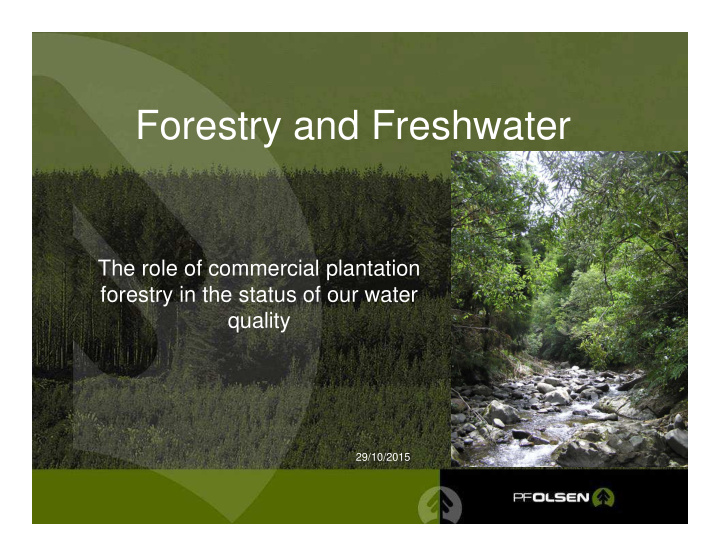



Forestry and Freshwater The role of commercial plantation forestry in the status of our water quality 29/10/2015
Plantations in the local mix • Landuse – Plantations 13% – Indigenous 14% – Scrublands 7% – Grassland 41% – Urban 15%
What does the data tell us
National Data = generally encouraging Other regions Auckland 6% of sample • National datasets generally indicates plantation forests maintain an average status a bit below undisturbed native forest but above pastoral farming and urban. • Other regional data confirms…. But pure forestry sites underrepresented.
2001-02 120 2002-03 131.1111 2003-04 100 Other examples 2004-05 136.3636 2005-06 135.4545 2007-08 141.1111 2008-09 131.25 2012-13 123.8095 Mangapapa Bay of Plenty West Coast 2013 MCI results German Sunday Austrians Redjacks Ongionui Blackmum Moores Palmers Gully Location Creek Ck Creek (12 Mile) s Ck Creek Creek Stream MCI 136 127 146 139 130 114 116 145 QMCI 6 6 8 8 6 7 8 8 Sunday Creek Estimated fishing area = 220m2 Fish abundance (fish/m2) 2003 2006 2008 2010 MCI 160 Longfin eel 0.073 0.095 0.005 0 Shortfin eel 0 0.009 0.005 0 140 Inanga 0 0 0 0 120 Koaro 0.16 0.06 0.01 0 Shortjaw kokopu 0 0 0 0 100 Banded Kokopu 0.28 0.36 0.11 0.02 80 Brown trout 0 0 0 0 Bluegill bully 0 0 0 0 60 Upland bully 0 0 0 0 40 Redfin bully 0.04 0.03 0.05 0 Dwarf galaxias 0 0 0 0 20 Lamprey 0 0.015 0 0 0 2002 2003 2004 2005 2006 2008 2009
Water Temperature Measured from a long term in-forest monitoring site during harvest.
Forestry’s concern – Periodic sedimentation • At time of harvest and particularly earthworks. • Predominantly in small headwaters streams. • Exacerbated by historic plantings right to stream edge and or poor establishment layout relative to harvesting needs. • Second rotations should be better.
Forestry’s concern – Periodic sedimentation • Highly erodible sedimentary Pakuratahi Study – Hawkes Bay formations. • Paired catchments – pastoral grazing (sheep) and plantation. • Standard practice at the time. • Peak during harvesting – more specifically roading earthworks. • Declines quickly afterwards • Overall sediment yield still well down on pastoral landuse.
Forestry’s concern – Periodic sedimentation
Forestry’s concern – Periodic sedimentation
Forestry’s concern – Periodic sedimentation
So what does the industry do? Responsible operators should…… • Be working to Industry codes. • Increasing focus on good planning and execution. • Increasing focus on water – Voluntary setbacks on all streams… – 5m streams up to 3.0 wide. – 10m all larger streams. – Sediment controls.
How the codes/rules start to play out….
Biggest risk – Debris flows • Landslides deposit orders of magnitude more sediment. • High intensity storm events more frequent...climate change? • Much of NZ forestry on steeplands…failed under pasture but plantation system not bomb proof!
Stream Recovery -Issue subject to some joint research between Industry and BoP RC Media attention has tended to focus on Forestry as the cause of many landsliding incidents during these storms. In reality while forestry practice has been a contributing factor in some cases it has not been a major driver in many. 2010-2011 LAST 2 YEARS IN BOP 4-5 HOUSES DAMAGED OR DESTROYED +1 FATALITY
Other influences
Flood amelioration • Forests – Canopies intercept about 20% of rainfall in low - moderate rainfall events. – Root systems and low compaction allow rain infiltration. – Below about 30% clearance in an individual catchment, hydrological effects unlikely. – In very intense storms – moderation effect reduced. – Dryland environments or over- allocated water demand, plantations may reduce peak yield.
Biodiversity Fauna Terrestrial/wetland reserves 10,600ha reserves = 19%
Ecosystem Services
Recommend
More recommend